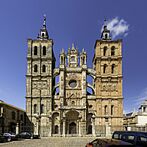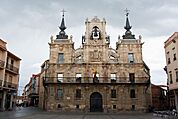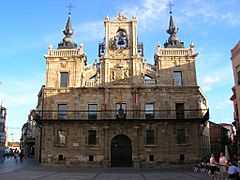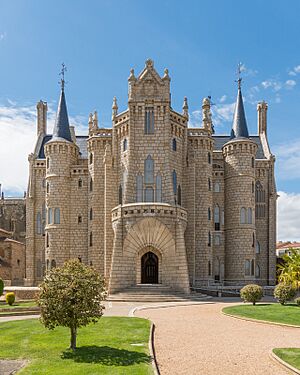Astorga, Spain facts for kids
Quick facts for kids
Astorga
|
|||
|---|---|---|---|
|
|
|||
|
|||
| Country | |||
| Autonomous community | |||
| Province | León | ||
| Comarca | La Maragatería | ||
| Judicial district | Astorga | ||
| Area | |||
| • Total | 46.78 km2 (18.06 sq mi) | ||
| Elevation | 870 m (2,850 ft) | ||
| Population
(2018)
|
|||
| • Total | 11,029 | ||
| • Density | 235.76/km2 (610.62/sq mi) | ||
| Demonym(s) | Astorganos | ||
| Time zone | UTC+1 (CET) | ||
| • Summer (DST) | UTC+2 (CEST) | ||
| Postal code |
24700
|
||
| Dialing code | 987 | ||
| Climate | Csb | ||
Astorga is a city and municipality in Spain. It is located in the center of the León province. This area is part of the Castile and León region. Astorga is about 43 kilometers (27 miles) southwest of the provincial capital, León.
The city sits between the flat Páramo Leonés and the mountains of León. It is a key city for the areas known as Maragatería, La Cepeda, and Ribera del Órbigo. Astorga is home to one of Spain's oldest and largest dioceses (a church district led by a bishop). It also serves as a main legal center for its part of León province.
Astorga is in the area of the Maragatos. This is a small group of people with special customs and buildings. The city is a meeting point for two important pilgrimage routes. These are the French Way and the Silver Route of the Way of St. James (Camino de Santiago). Saint Turibius of Astorga was a bishop here in the 400s.
Contents
Discovering Astorga's Past
Astorga has a very long history. People have lived in this area for over 200,000 years. This was even before the Paleolithic (Old Stone Age).
Ancient Times: Early Humans and Celts
About 209 kilometers (130 miles) from Astorga are the Atapuerca Mountains. Here, scientists found many old human fossils. These fossils tell us a lot about how early humans looked and lived in Spain. The local government protects this important historical site.
Around 2750 BC, people in the Astorga area used tin to make tools. Later, during the Bronze Age (about 1300–700 BC), people made special axes. These axes are linked to the Castro culture in the Atlantic region.
In the Iron Age, the Celts influenced the area. Local Celtic groups, like the Astures and Cantabri, lived here around 275 BC. Later, the Romans came and made Astorga one of their strongholds. They called it Asturica.
Roman Empire: A Powerful City

The Roman Empire founded the city of Asturica Augusta in 14 BC. This happened during the Cantabrian Wars (28–19 BC). Roman armies built a military camp here. It was placed well between the Jerga and Tuerto rivers. This camp was important because of local uprisings and its closeness to the gold mines of Las Médulas.
Astorga became a major center for government and the military. The Roman walls were rebuilt around 1242. The city had public baths with hot and cold water. It also had two main sewer systems that are still used today. You can still see parts of the Roman baths.
In 35 AD, the Roman camp was rebuilt into a city. It became a provincial capital. Four important Roman roads met here. The Silver Way (Ruta de la Plata) connected Astorga to Mérida in the south. This road was built to transport gold and other goods. Pliny the Elder wrote about the Silver Way in 73 AD. It stretched about 900 kilometers (560 miles).
Astorga was the most important city in northwest Spain during Roman times. Pliny the Elder called it Urbs magnifica, meaning "magnificent city." Astorga was also one of the first three places in Spain to have a bishopric. This means it had a bishop leading the local church.
Visigothic Kingdom: Changes and Challenges
The Visigoths, a Germanic tribe, attacked Astorga in the 400s. In 456 AD, the Visigothic King Theodoric II defeated the Suebic King Rechiar near Astorga.
During this time, Bishop Turibius of Astorga was important. He saw the Suebic King Remismund become an Arian Christian. Turibius also worked to fix churches destroyed by the Visigoths. He traveled to Rome and brought back what is believed to be a piece of the True Cross. He founded a monastery, Santo Toribio de Liébana, to keep it safe.
Christianity became popular in Astorga because of Roman rule. There is a story that Saint James and St. Paul both preached here. Astorga had a bishopric by the 3rd century. Even after the Visigoths took over and damaged the Roman city, Astorga grew with the help of saints like Turibius.
Reconquista: Rebuilding and New Life
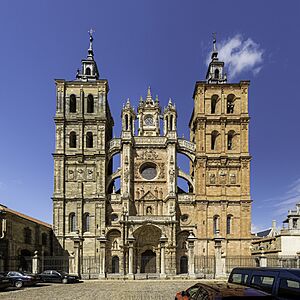
After the Berbers left and Christian armies fought back, Astorga was empty for a while. It was in a buffer zone between Christian and Muslim lands. In the 800s, during the reign of Ordoño I of Asturias, people began to settle there again.
Astorga became less important until the 11th century. Then, it became a major stop for pilgrims on the French Way to Santiago de Compostela. The building of the cathedral started in the 1400s and finished in the late 1700s.
Jewish people lived in Astorga as early as the 1000s. They had their own neighborhoods. Many Jews were forced to convert to Christianity in 1230–31. The Jewish community existed until 1492, when all Jews were expelled from Spain. Jewish people helped develop trades in the city. Today, Astorga is known for its special local products.
Modern Age: Chocolate, Cakes, and Pilgrims
In 1528, Hernán Cortés brought Mexican cacao beans to Spain. Astorga became a pioneer in making chocolate from the 1600s. This was thanks to the Marquisate of Astorga, the Diocese, and the Maragato muleteers. In 1914, there were 49 chocolate makers in the town! You can see 16th-century hot chocolate mugs in Astorga's chocolate museum.
In 1747, a recipe for Mantecadas de Astorga appeared in a book. These are small, muffin-like cakes. It is believed a nun from a local convent created the recipe. The European Union has recognized them as an important part of Spanish food history. In 1930, Spanish railways carried 208 tons of Mantecadas from Astorga. Many are sold to tourists, along with Hojaldres de Astorga (puff pastry).
During the Peninsular War (1808–1814), French troops led by Napoleon attacked Astorga. Napoleon himself stayed in Astorga, making it the farthest town in Spain he visited. The French tried to capture Astorga in 1810. They wanted to use it as a base for their invasion of Spain and Portugal.
Astorga was a resting place for pilgrims because of its location. It had 21 hospices (places for travelers to stay). Today, there is the Hospital de las Hermana de la Caridad. This medical center was built after a 12th-century hospital was destroyed in 1756.
The Camino de Santiago ("St. James's Way") is a 780-kilometer (485-mile) pilgrimage. It leads to the cathedral in Santiago de Compostela. There, the remains of Saint James are said to be buried. This pilgrimage has been important for over 1,000 years. Astorga is a key stop on this route. The 2010 movie The Way, starring Martin Sheen and Emilio Estevez, shows people walking the Camino de Santiago.
In the late 1800s, the railway came to Astorga. The city grew outside its old Roman walls. Astorga became an important center for roads again. It regained its social and economic energy, with tourism becoming a main focus.
Must-See Attractions in Astorga
- Cathedral of Santa María de Astorga: A beautiful church built over many centuries.
- Episcopal Palace: A stunning building from the 1800s. It was designed by the famous architect Antoni Gaudí.
- Town Hall: This Baroque-style building started construction in 1683. It has three towers on its front, with bells in the middle one.
- Roman Remains: Explore parts of the original Roman military camp. See the old sewers, two bathhouses, and parts of the forum. You can also find ancient mosaics.
- Roman Museum (La Ergastula): Learn more about Astorga's Roman past here.
- Ancient City Walls: Walk along the remains of the old city walls.
- Chocolate Museum: Discover the history of chocolate making in Astorga.
Fun Events in Astorga
- Festividad de Santa Marta: This festival takes place in the last week of August. It includes exciting bullfights and dazzling fireworks!
Famous People from Astorga
- Miguel Arias Bardou (1841–1915) - A talented painter.
- José Aragón Escacena (1891-1945) - A well-known writer.
Sister Cities
Astorga has special connections with these cities:
See also
 In Spanish: Astorga para niños
In Spanish: Astorga para niños


